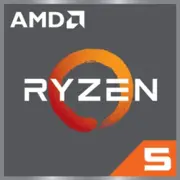AMD Ryzen 5 2400G

AMD Ryzen 5 2400G: An Analysis of the 2025 Budget APU
Updated: April 2025
1. Key Specifications: Architecture and Performance
Raven Ridge Architecture and 14nm Process
The AMD Ryzen 5 2400G, released in 2018, is one of the first APUs (Accelerated Processing Units) based on the Zen architecture. This hybrid processor combines 4 cores/8 threads CPU and integrated Radeon Vega 11 graphics. The 14nm process provides a balance between performance and energy efficiency (TDP of 65W).
Key Features:
- SMT (Simultaneous Multithreading): Supports 8 threads for multitasking.
- Vega 11 Graphics: 11 compute units (704 stream processors) with a frequency of up to 1250 MHz.
- Precision Boost 2: Automatic boost up to 3.9 GHz for single-threaded tasks.
- 4 MB L3 Cache: Minimum for gaming and basic workloads.
Performance in 2025:
- Geekbench 6: 1006 (Single-Core), 3040 (Multi-Core).
- Gaming: CS:GO — 60-80 FPS on medium settings (1080p), GTA V — 40-50 FPS (low settings).
- Work Tasks: Light photo editing in Photoshop, rendering simple 3D models in Blender (up to 30 minutes).
2. Compatible Motherboards
AM4 Socket and Chipsets
The Ryzen 5 2400G uses the AM4 socket, allowing it to be installed on motherboards with the following chipsets:
- A320/B350/X370: Budget options, but without overclocking (A320) or with limited functionality.
- B450/X470: Optimal choice with support for Precision Boost Overdrive and BIOS updates for compatibility with newer processors.
Examples of motherboards in 2025:
- ASRock B450M Pro4 (price: ~$75): Good VRM, two M.2 slots.
- Gigabyte X470 AORUS Ultra Gaming (~$110): Enhanced upgrade options.
Important: To activate XFR (overclocking), BIOS version P4.70 or later is required.
3. Supported Memory: DDR4 and Dual-Channel Mode
The Ryzen 5 2400G works only with DDR4 (officially up to 2933 MHz, but overclocking to 3200 MHz is possible). Dual-channel mode is critical for maximizing the performance of Vega 11 graphics.
Recommendations:
- 2×8 GB DDR4-3200 (e.g., Kingston HyperX Fury ~$50 for the kit).
- Avoid single-channel configurations — FPS in games can drop by up to 30%.
4. Power Supply: Power Calculation
With a TDP of 65W and no discrete graphics card, a 400W PSU is sufficient. However, for future upgrades (e.g., adding an RX 6600), it's better to choose a model in the range of 500–550W.
Examples:
- EVGA 500 BR (~$45): A reliable budget option.
- Corsair CX550M (~$65): Semi-modular design, 80+ Bronze certification.
Tip: Don’t skimp on the PSU — low-quality units can damage components.
5. Pros and Cons of the Ryzen 5 2400G
Advantages:
- Integrated Graphics: Best in its class (2018–2020).
- Energy Efficiency: Suitable for compact builds (Mini-ITX).
- Price: New units in 2025 — $90–$120 (only leftovers in stock).
Disadvantages:
- 4 Cores: A bit too few for modern AAA games and heavy video editing.
- No PCIe 4.0: Limited speed for NVMe drives.
- Outdated Process Technology: 14nm compared to 7nm in Ryzen 5000/7000.
6. Usage Scenarios
Gaming:
- Esports: Dota 2, Overwatch 2, Valorant — 60+ FPS on medium settings.
- AAA Titles: Cyberpunk 2077 — 25–30 FPS (720p, low settings).
Work Tasks:
- Office applications, web development, light editing in DaVinci Resolve.
Multimedia:
- 4K video streaming via HDMI 2.0, HDR support.
7. Comparison with Competitors
Intel Core i5-8400 (6 cores/6 threads):
- Better in single-threaded tasks but requires a discrete graphics card. Price in 2025: ~$130 (new).
AMD Ryzen 5 3400G (Vega 11, 4 cores/8 threads):
- Slight frequency increase (3.7–4.2 GHz) but more expensive (~$140).
Intel Core i3-12100 (2022):
- Higher IPC, DDR5 support, but weak UHD 730 graphics. Price: ~$110.
8. Assembly Tips
- Motherboard: Choose B450 with BIOS Flashback for upgrades to Ryzen 5000.
- Cooling: The stock cooler is sufficient, but for quiet operation — Arctic Freezer 34 (~$30).
- Storage: NVMe SSD (e.g., WD Blue SN570 500GB — ~$45) for faster boot times.
- Case: Cooler Master MasterBox Q300L (~$60) with ventilation for the APU.
9. Final Conclusion: Who is the Ryzen 5 2400G Suitable For?
This processor is relevant for:
- Budget Gamers not ready to purchase a discrete graphics card.
- Office PCs with ample multitasking capabilities.
- Home Theater Builders creating media centers or compact systems.
Why in 2025? Despite its age, the 2400G remains one of the most affordable APUs with decent graphics. However, for professional tasks or modern gaming, it is better to consider the Ryzen 5 5600G or Intel Core i5-12400 with UHD 730 + discrete GPU.
Note: Prices are listed for new devices as of April 2025. The used market offers the 2400G for $50–$70, making it even more appealing for budget-conscious users.
Basic
CPU Specifications
Memory Specifications
GPU Specifications
Miscellaneous
Benchmarks
Compared to Other CPU
Share in social media
Or Link To Us
<a href="https://cputronic.com/en/cpu/amd-ryzen-5-2400g" target="_blank">AMD Ryzen 5 2400G</a>